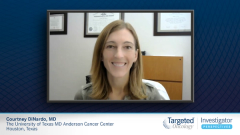
The VIALE-A Trial: Venetoclax plus Azacitidine in AML Treatment
Dr Courtney DiNardo reviews the efficacy data from the VIALE-A trial and explains the rationale for combining venetoclax with azacitidine as a treatment option for patients with AML.
Courtney DiNardo, MD: The rationale to look at venetoclax in combination with the hypomethylating agents azacytidine or decitabine came from those who worked in the lab studying AML [acute myeloid leukemia]. Marina Konopleva at [The University of Texas] MD Anderson [Cancer Center], Tony Letai, Dan Pollyea. They saw this dramatic synergy in patients with leukemia who were getting venetoclax in combination with hypomethylating agents. Venetoclax was evaluated first as a single agent in the relapsed setting, and…we saw very modest responses of less than 20%. It’s a testament to some of these great translational researchers that we moved it to a frontline combination. There was such strong preclinical data that this was going to be a benefit, and it was.
The initial phase 1 study showed dramatic responses. Within a cycle, the majority of patients were going into a remission. That moved into the phase 3 Viale-a study to confirm this benefit, and that was a randomized placebo-controlled study conducted globally. Hundreds of patients were enrolled, and two-thirds of patients responded to the combination of azacytidine and venetoclax with a complete remission or a complete remission with incomplete count recovery. A composite remission is what we call it, and that correlated with an improved overall survival. An improvement in overall survival and median survival was 15 months, compared with about 10 months. In my opinion, we’re still not done. The story doesn’t end here. But it’s the first randomized phase 3 study of older, intensive-chemotherapy-ineligible patients with AML to show a survival benefit of anything compared with a hypomethylating agent alone. This is a huge advance in our field. We’ve seen many patients respond and do quite well with this regimen.
What’s great about the combination of azacytidine and venetoclax is that it’s genomically agnostic, meaning that you don’t have to have a specific genomic subtype to respond to this therapy. In the original studies, we looked at patients with high-risk, poor-risk, and intermediate-risk cytogenetics, therapy-related disease, various mutational patterns. All these patients do better with the combination than with azacytidine alone as was proven in the Viale-a study. It’s appropriate for any newly diagnosed patient AML who’s not a good candidate for standard intensive chemotherapy.
To go a little more into the weeds, we’ve realized that certain mutations predict a more durable remission. Individuals with NPM1 mutations or IDH2 mutations do particularly well. These patients had deep remissions that may even turn into cures. However, patients with TP53 mutations, for instance, respond, but they unfortunately have relatively short responses and a shorter overall survival, so we still need to improve the outcomes of patients with TP53 mutations.
Transcript edited for clarity.









































